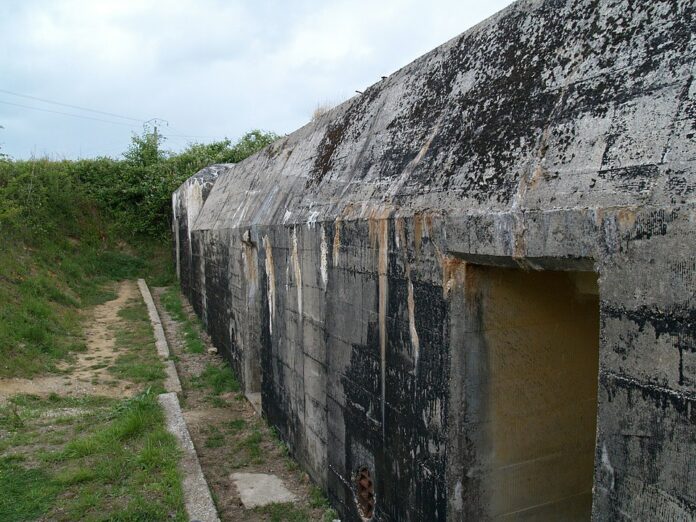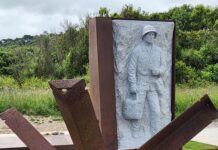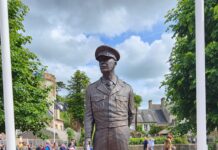(Photo courtesy of Wikimedia)
Sometime in 1943 the German occupying force in Normandy began construction of a coastal gun battery near the inland village of Maisy about 7 km west of the now better known battery located on the Pointe du Hoc. The Maisy Battery was apparently not fully operable by June 6, 1944. It was bombed by the RAF and shelled by Allied war ships on D-Day, but not overrun by ground forces until the 8th when a mixed force from the 1st Battalion, 116th Infantry and 5th Rangers fought through the area to clear enemy resistance as far west as the Vire River.
Whether the Maisy Battery fired on either Utah or Omaha beach on D-Day has been a matter of dispute ever since entrepreneur-turned-historian Gary Sterne published the details of his rediscovery of the battery in “The Cover-Up At Omaha Beach: D-Day, the US Rangers, and the Untold Story of Maisy Battery” (Great Britain: Pen and Sword Ltd, 2013; reprint New York: Skyhorse Publishing, 2014). Sterne argues that the Germans were constructing the battery in secret using non-French workers, while the much more visible coastal battery under construction on the Pointe du Hoc was merely a decoy designed by Erwin Rommel to deflect Eisenhower’s attention from Maisy, the real threat. Sterne maintains that Neptune intelligence was fooled completely by the ruse and that Ike considered the Pointe du Hoc battery, with its casemates shielding six 155-mm cannon, the greatest potential threat to the American beaches right through D-Day.
The planners responded to that threat by committing two battalions of elite U.S. Army Rangers to improbable amphibious assaults that in one instance involved scaling the steep 90’-100’ cliff towering above the Pointe’s tiny shingle beach. (Companies B, C and D of the 2d Ranger Battalion carried out that assault, a force of a little over 200 men given the 70+man-size of the Ranger companies. Other Rangers from both the Second and Fifth Battalions stormed ashore on Charlie Sector of Omaha Beach taking heavy losses there as well.) As all D-Day buffs know, the Pointe du Hoc casemates were armed with “Quaker guns” on D-Day, but the five missing 155-mm French-made cannon, with ammunition, were found a thousand yards inland apparently sited to fire on the beaches. The Rangers spiked the guns, cut the coastal road, and spent the next two days taking heavy casualties while fending off German counterattacks and waiting to be relieved.
While searching for a locale to open a D-Day museum-attraction in 2004, Sterne stumbled on the Maisy Battery, by that time almost obliterated from view and memory, eventually bought the property and excavated the parts of the site now open to the public.
His claim that the existence of the battery was deliberately erased after D-Day with Eisenhower’s approval, its underground bunkers later filled in, seems unlikely to us. The failure to neutralize the Maisy Battery adequately after all the effort to eradicate the guns on the Pointe du Hoc was more likely an intelligence SNAFU, unlikely to generate any special need for a high-level “cover-up.” Certainly, German artillery continued to harass Omaha Beach all through D-Day, but after 75 years, how much of that fire came from Maisy now can’t be determined. None of the large-gun-batteries strung out behind the landing beaches from St. Marcouf to Merville was able to do more than harass the landings, although, while they were in play, they certainly slowed and obstructed Allied landing efforts.
To reach the Maisy Battery, leave the Pointe du Hoc (or Grandcamp) via D 514 and skirt Maisy where the highway bends to the southwest. Just after you pass by the village you will reach a road (Les Perrugues) teeing off the highway to your right (west). The Maisy Battery is a short distance down that road with parking on the east side in front of the entrance. Watch your step. The trails leading to the gun emplacements (with German artillery pieces in place) and bunkers are somewhat narrow and unimproved.
Maisy Battery Part of Discovery Channel Show…
Recently (early 2020), The Discovery Channel aired a program in its Expedition Unknown series (“D-Day Uncovered”) featuring their intrepid investigator, John Gates, participating in the partial excavating of two underground, reinforced-concrete Nazi bunkers heretofore unopened.
Despite trying to obfuscate his audience these bunkers were being serendipitously discovered while professional camera and backhoe crews hovered nearby, Gates and site owner/operator, Gary Sterne, make a convincing case that no one had entered them in 75 years. Both bunkers, one thought to be for ammunition storage and the other a protected barracks for the gun crews, were empty. Whatever had once filled those structures was long gone; left behind was a battered Wehrmacht helmet and belt buckle, neither worth much on today’s Normandy souvenir market. The odds are that U.S. Army ordnance disposal units had cleared the ammunition bunker right after D-Day and the local civilians had soon salvaged what else the Germans left behind.
What we are left with then is an expertly guided tour of the Maisy site, which can’t but impress one with its size and complexity. But, don’t forget that the cannon you see on their hard stands are surplus guns brought in by Sterne after he purchased the site.
Our thanks to Brink Trammel, USNA ’57 who critiqued this piece.
























